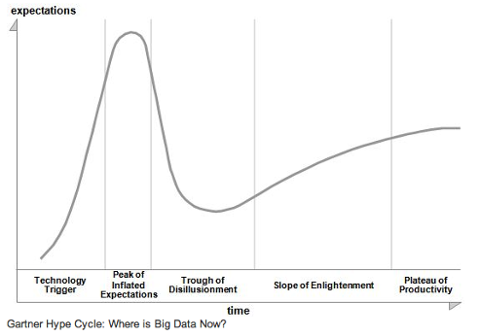 Whether or not one regards “Big Data” as one of those empty buzz-phrases that seize the business world’s collective imagination every few years, new data from research firm Gartner suggests that analyzing massive amounts of machine and social data will become big business over the next year. Gartner believes that Big Data will create $28 billion in worldwide spending this year, rising to $34 billion in 2013. Most of that spending will involve upgrading “traditional solutions” to handle the flood of data entering organizations from a variety of sources, including social networks, sensors and customer interactions; the firm believes that a mere $4.3 billion in sales will come from “new big data functionality.” "In 2011, big data formed a new driver in almost every category of IT spending,” Mark Beyer, research vice president at Gartner, wrote in an Oct. 17 statement. “However, through 2018, big data requirements will gradually evolve from differentiation to 'table stakes' in information management practices and technology.” By 2020, he added, “Big data features and functionality will be non-differentiating and routinely expected from traditional enterprise vendors and part of their product offerings." Because of that trend, data analytics will end up more embedded into “traditional” software platforms, becoming just another feature set as opposed to a competitive differentiator. And once that happens, the advantage of tailor-designed “Big Data” software over business software will decline. "Because big data's effects are pervasive,” Beyer continued, “big data will evolve to become a standardized requirement in leading information architectural practices, forcing older practices and technology into early obsolescence." In other words, integrated data analytics could become the “new normal” for hardware and software—good for any organization looking to make sense of the data flooding their organizations, but also a trend that could make things more complicated for any IT pro trying to manage their organization’s hardware and software stack. Image: Pavel Ignatov/Shutterstock.com
Whether or not one regards “Big Data” as one of those empty buzz-phrases that seize the business world’s collective imagination every few years, new data from research firm Gartner suggests that analyzing massive amounts of machine and social data will become big business over the next year. Gartner believes that Big Data will create $28 billion in worldwide spending this year, rising to $34 billion in 2013. Most of that spending will involve upgrading “traditional solutions” to handle the flood of data entering organizations from a variety of sources, including social networks, sensors and customer interactions; the firm believes that a mere $4.3 billion in sales will come from “new big data functionality.” "In 2011, big data formed a new driver in almost every category of IT spending,” Mark Beyer, research vice president at Gartner, wrote in an Oct. 17 statement. “However, through 2018, big data requirements will gradually evolve from differentiation to 'table stakes' in information management practices and technology.” By 2020, he added, “Big data features and functionality will be non-differentiating and routinely expected from traditional enterprise vendors and part of their product offerings." Because of that trend, data analytics will end up more embedded into “traditional” software platforms, becoming just another feature set as opposed to a competitive differentiator. And once that happens, the advantage of tailor-designed “Big Data” software over business software will decline. "Because big data's effects are pervasive,” Beyer continued, “big data will evolve to become a standardized requirement in leading information architectural practices, forcing older practices and technology into early obsolescence." In other words, integrated data analytics could become the “new normal” for hardware and software—good for any organization looking to make sense of the data flooding their organizations, but also a trend that could make things more complicated for any IT pro trying to manage their organization’s hardware and software stack. Image: Pavel Ignatov/Shutterstock.com Big Data Spending Will Hit $28 Billion in 2012: Gartner
 Whether or not one regards “Big Data” as one of those empty buzz-phrases that seize the business world’s collective imagination every few years, new data from research firm Gartner suggests that analyzing massive amounts of machine and social data will become big business over the next year. Gartner believes that Big Data will create $28 billion in worldwide spending this year, rising to $34 billion in 2013. Most of that spending will involve upgrading “traditional solutions” to handle the flood of data entering organizations from a variety of sources, including social networks, sensors and customer interactions; the firm believes that a mere $4.3 billion in sales will come from “new big data functionality.” "In 2011, big data formed a new driver in almost every category of IT spending,” Mark Beyer, research vice president at Gartner, wrote in an Oct. 17 statement. “However, through 2018, big data requirements will gradually evolve from differentiation to 'table stakes' in information management practices and technology.” By 2020, he added, “Big data features and functionality will be non-differentiating and routinely expected from traditional enterprise vendors and part of their product offerings." Because of that trend, data analytics will end up more embedded into “traditional” software platforms, becoming just another feature set as opposed to a competitive differentiator. And once that happens, the advantage of tailor-designed “Big Data” software over business software will decline. "Because big data's effects are pervasive,” Beyer continued, “big data will evolve to become a standardized requirement in leading information architectural practices, forcing older practices and technology into early obsolescence." In other words, integrated data analytics could become the “new normal” for hardware and software—good for any organization looking to make sense of the data flooding their organizations, but also a trend that could make things more complicated for any IT pro trying to manage their organization’s hardware and software stack. Image: Pavel Ignatov/Shutterstock.com
Whether or not one regards “Big Data” as one of those empty buzz-phrases that seize the business world’s collective imagination every few years, new data from research firm Gartner suggests that analyzing massive amounts of machine and social data will become big business over the next year. Gartner believes that Big Data will create $28 billion in worldwide spending this year, rising to $34 billion in 2013. Most of that spending will involve upgrading “traditional solutions” to handle the flood of data entering organizations from a variety of sources, including social networks, sensors and customer interactions; the firm believes that a mere $4.3 billion in sales will come from “new big data functionality.” "In 2011, big data formed a new driver in almost every category of IT spending,” Mark Beyer, research vice president at Gartner, wrote in an Oct. 17 statement. “However, through 2018, big data requirements will gradually evolve from differentiation to 'table stakes' in information management practices and technology.” By 2020, he added, “Big data features and functionality will be non-differentiating and routinely expected from traditional enterprise vendors and part of their product offerings." Because of that trend, data analytics will end up more embedded into “traditional” software platforms, becoming just another feature set as opposed to a competitive differentiator. And once that happens, the advantage of tailor-designed “Big Data” software over business software will decline. "Because big data's effects are pervasive,” Beyer continued, “big data will evolve to become a standardized requirement in leading information architectural practices, forcing older practices and technology into early obsolescence." In other words, integrated data analytics could become the “new normal” for hardware and software—good for any organization looking to make sense of the data flooding their organizations, but also a trend that could make things more complicated for any IT pro trying to manage their organization’s hardware and software stack. Image: Pavel Ignatov/Shutterstock.com 

